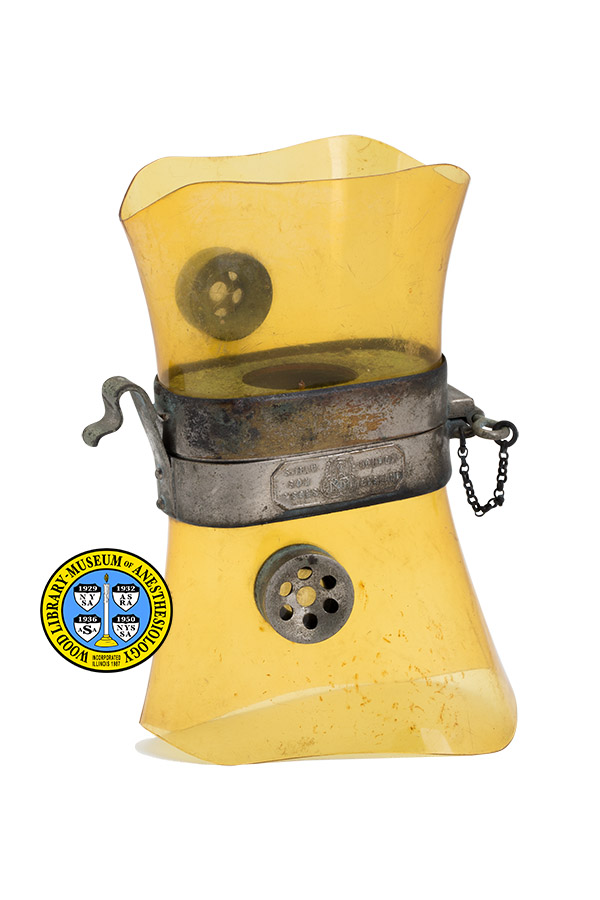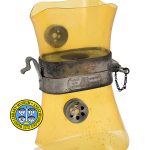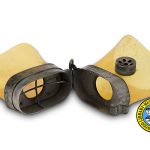Carter Double-ended Inhaler
The open-drop technique of anesthesia was popular from the late-19th to the mid-20th centuries. Most open-drop masks consisted of a metal frame covered with cloth, onto which liquid anesthetic would be added drop by drop until the cloth was saturated. The Carter Inhaler is an open-drop device of very unusual design. Instead of a frame, it combines one large and one small mask, both made of celluloid. Each mask has an expiratory valve, a feature that was more often seen in enclosed inhalers.
The metal fittings in the center of the inhaler hold the two masks back-to-back. The hinge allows the device to be opened to insert a medium to hold the anesthetic, such as sponge or a pad of gauze. Many anesthesia masks and inhalers were meant for use with one specific agent. The Carter Inhaler was advertised for use with any one of several agents, including ether, chloroform, ethyl chloride, and A. C. E. (a combination of alcohol, ether and chloroform.) The example shown here was made by the London instrument manufacturer, S. Maw, Son & Sons, and was probably introduced in the 1920s.
Catalog Record: Carter Double-ended Inhaler Carter Inhaler
Access Key: apov
Accession No.: 2005-07-25-1
Title: [Carter inhaler] / S. Maw, Son & Sons.
Corporate Author: S. Maw, Son & Sons.
Title variation: Alt Title
Title: Carter double-ended chloroform inhaler
Title variation: Alt Title
Title: Carter open method inhaler.
Publisher: London, England : S. Maw, Son & Sons, [between 1925 and 1959].
Physical Description: 1 anesthesia inhaler : celluloid, metals, mica ; 15 x 6.5 x 10.5 cm.
Subject: Anesthesia, Inhalation – instrumentation.
Subject: Inhalers, Anesthesia – Great Britain.
Note Type: General
Notes: The cataloger could find no information about the eponymous attribution.
The first year in the date range is based on the fact that the inhaler did not appear in available Maw catalogs dated as late as 1925. But this form of the company’s name was in use by 1900, and the actual date of manufacture could be earlier. The second year in the date range is based on the date that Maw was acquired by Narcos.
The construction of this inhaler is such that there can be no single, correct orientation. It is described with the larger mask face-down and the smaller mask seated above it, and with the maker’s marks facing the viewer.
Note Type: Citation
Notes: Bailey Company File. Archives. Located at: Wood Library-Museum of Anesthesiology, Schaumburg, Illinois.
Note Type: Citation
Notes: The Chemical Heritage Foundation website. https://www.chemheritage.org/distillations/magazine/celluloid-the-eternal-substitute. Accessed March 14, 2017.
Note Type: Original
Notes: S. Maw, Son and Sons. Illustrations of Medical, Surgical, and Sundry Appliances in S. Maw, Son & Sons’ Quarterly Price List. London: S. Maw, Son & Sons, 1903.
Note Type: Citation
Notes: S, Maw, Son & Sons. Catalogue of Surgical Instruments & Appliances, Aseptic Hospital Furniture and Surgical Dressings, Etc. London: S. Maw, Son & Sons, January, 1905.
Note Type: Citation
Notes: S. Maw, Son. Catalogue of Medical, Surgical and Druggists’ Sundries. London: S. Maw, Son & Sons, 1911.
Note Type: Citation
Notes: Maw HT, ed. A Catalogue of Surgical Instruments, Appliances, Aseptic Hospital Furniture, Surgical Dressings, Etc. London: S. Maw, Son & Sons, Ltd., 1925.
Note Type: Citation
Notes: Maw Company File. Archives. Located at: Wood Library-Museum of Anesthesiology, Schaumburg, Illinois.
Note Type: Citation
Notes: The Plastics Historical Society website. http://plastiquarian.com/?page_id=14221. Accessed March 14, 2017.
Note Type: Citation
Notes: James Woolley, Sons & Co, Ltd. Catalogue of Surgical Instruments and Appliances. Manchester: James Wooley, Sons & Co., Ltd., 1931:8 and 137.
Note Type: Physical Description
Notes: One anesthesia inhaler; Consists of two masks of unequal size, connected back-to-back; The upper mask is the smaller of the two; Each mask is made of celluloid with metal fittings; The celluloid of each mask is shaped in a roughly triangular cylinder with a scalloped bottom edge; Each mask has a metal expiratory valve mounted on one side; Each valve contains a disc of mica; The celluloid is yellow and fragile, and there is a crack in the back of the larger mask; All of the metal fittings have some corrosion;
The upper edge of each mask is seated in a metal band that holds a metal platform with a circular opening in the center; The two metal bands are of unequal height; The platform of the smaller mask is approximately 1.75 centimeters tall, while that of the larger mask is approximately 1.5 centimeters tall; The opening in the platform of the smaller mask holds two, crossed wire struts; The metal bands are connected by a metal hinge on the right (the “back” of each mask) and a metal clip on the left; The hinge clasps a cotter pin which is chained to the lower half of the hinge; The band of the larger mask bears a cartouche that contains the following markings: on the left, “S. Maw, Son & Sons”, and on the right “London, England”; In the center appears the company logo; The masks can be pulled away from one another by pressing down on the hinge, but doing so is not recommended due to the fragility of the celluloid.
Note Type: Reproduction
Notes: Photographed by Mr. Steve Donisch, November 15, 2016.
Note Type: Historical
Notes: In the late 19th and early 20th centuries, most of the face masks and inhalers made for the administration of anesthesia were opaque. Masks that were integral to hand-held inhalers were usually made of materials such as leather or metal. In masks used for the open-drop technique, cloth was stretched over a wire frame and saturated with a liquid anesthetic such as chloroform.
By using a transparent mask, the patient’s breathing could be monitored without interrupting the anesthetic by lifting the mask. Airway obstruction due to aspirated stomach contents could also be readily observed. The earliest known glass anesthesia mask was introduced by Christopher Fleming in 1850. The first known celluloid anesthesia mask was introduced by J. F. W. Silk in 1894. The Silk Inhaler was available in two models, either all-metal, or celluloid.
Celluloid is considered the first modern plastic. Developed in the 1860s, it was first used to make billiard balls, and has been part of numerous other products for over a century. A celluloid anesthesia mask had the advantage of being much lighter in weight than glass. But it is a highly flammable material, and has largely been replaced by other plastics. The last known anesthesia mask to be made of celluloid was introduced by Slater and Stephen in 1951.
The configuration of the Carter inhaler is very similar to that introduced by Dr. W. J. McCardie in 1904. Both feature a large and a small mask, connected back-to-back. But the McCardie Inhaler was made entirely of metal. Also, it does not appear to have had a hinge between the two masks, nor expiratory valves. The McCardie inhaler was intended for use with “ether, or a mixture of ether and chloroform.”
It should be noted that, distinct from his inhaler, Dr. McCardie also introduced an open-drop mask of the wire frame type in 1906.
Maw, the manufacturer of the cataloged object, was founded in London around 1807. By 1900, the company name had become S. Maw, Son & Sons, a name which continued until the company was acquired by Narcos in 1959. The WLM owns four Maw catalogs published during that time span, dated 1903, 1905, 1911 and 1925, respectively; the Carter Inhaler does not appear in any of those catalogs.
The cataloger found only two sources that list the Carter Inhaler. One is the 1931 catalog of the Manchester instrument maker, James Woolley, Sons & Co. This company was in business by 1884, and continued into the 1960s.
The other source is an undated catalog of the London instrument maker, W. H. Bailey & Son. Founded in 1833, the company did business under that name from 1894 into the 1960s. The WLM has only the cut pages numbered 137-142. These give two addresses, appearing on alternate pages: “38 Oxford Street” and “2 Rathbone Place W.” Bailey’s 1931 catalog (which is not in the WLM collection) gives the address “45 Oxford Street”, while the Rathbone Place address is known to have continued in use through the 1950s. The cut pages are therefore likely to be no later in date than 1931.
Like the McCardie Inhaler, the Carter Inhaler was intended for use with more than one agent. Bailey’s catalog calls it: “Carter’s open method inhaler for ether, chloroform, A. C. E., ethyl chloride, etc.”. Woolley’s catalog calls it: “Carter’s double-ended chloroform inhaler…. for the administration of various anaesthetics.” Both the undated Bailey’s catalog and Woolley’s 1931 catalog offer both the Carter and the McCardie Inhalers.
Note Type: Publication
Notes: W. H. Bailey & Son. Catalogue of surgical instruments and appliances. London: W. H. Bailey & Son, 1931.
Note Type: Publication
Notes: McCardie WJ. A simple two-sided inhaler for the administration of a mixture of ether and chloroform (E2C1) or for ether alone. Lancet. July 16, 1904;164(4220):154.
Note Type: Exhibition
Notes: Selected for the WLM website.



